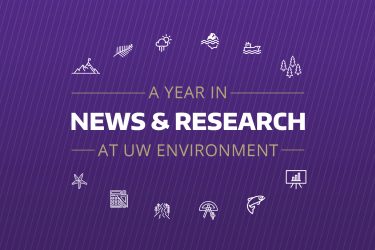
2019 is quickly approaching, and with it will come a new array of probing questions to be examined and research to be rigorously undertaken. As the new year unfolds, we are excited to learn more about the Earth and its ecosystems alongside you all. The new year will encompass new opportunities to grow academia’s capacity to communicate science outside of universities too, speaking directly to policy-makers, cities and communities, and individuals—a growing need in the fields we study.
But before that, we wanted to look back at just a few of the many examples of published research, news stories and other developments from around the College of the Environment in 2018. There was no shortage this year of incredible and meaningful work coming out of UW Environment, across all units and departments that make up the College, including:
January 2018
Civil War-era U.S. Navy Ships’ logs to be explored for climate data
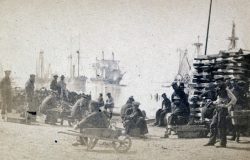
In January, funding was announced for a University of Washington-based team working to digitize Civil War-era U.S. Navy ships’ logbooks, muster rolls, and related materials from 1861 to 1879 to help scientists better understand modern climate change patterns and improve predictions. Kevin Wood, of the Joint Institute for the Study of the Atmosphere and Ocean and the project’s principal investigator said at the time, “The Civil War- and Reconstruction-rea logs we are targeting here are particularly useful to fill in and extend our knowledge of past weather conditions around the world, from the mid-19th century to the beginning of the 20th century.”
February 2018
Largest Chinook salmon disappearing from West Coast
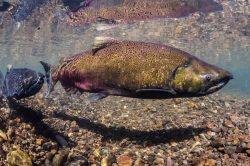
In February, new research showed that the largest and oldest Chinook salmon have mostly disappeared along the West Coast. Scientists analyzed nearly 40 years of data from hatchery and wild Chinook populations from California to Alaska, looking broadly at patterns that emerged over the course of four decades and across thousands of miles of coastline. In general, Chinook salmon populations from Alaska showed the biggest reduction in age and size, with Washington state’s salmon a close second. UW School of Aquatic and Fishery Sciences‘ Jan Ohlberger noted then that, “The largest fish are disappearing, and that affects subsistence and recreational fisheries that target these individuals.”
March 2018
Partnering with indigenous communities to anticipate and adapt to ocean change
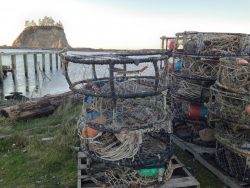
In March 2018, NOAA’s Ocean Acidification Program awarded scientists from the University of Washington’s Applied Physics Lab, Washington Sea Grant, and the Joint Institute for the Study of the Atmosphere and Ocean a $700,000 grant, along with federal and tribal partners, to study the social and ecological vulnerabilities of Olympic Coast ocean acidification. The Applied Physics Lab and School of Oceanography‘s Jan Newton said, “The goal of this project is to marry two currently disparate data sets: ocean chemistry and biological data by natural scientists, and social science data that includes how people use the resources that might be impacted [by ocean acidification].”
April 2018
Earth’s stable temperature past suggests other planets could also sustain life
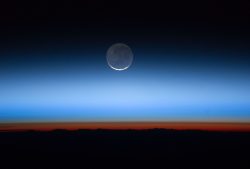
New research from University of Washington in April suggested a milder youth for our planet than what has often been cited. An analysis of temperature through early Earth’s history supports more moderate average temperatures throughout the billions of years when life slowly emerged from Earth. UW Earth and Space Sciences‘ David Catling said, “Ideas about the early Earth’s environment are all over the place… These simulations show that our early world had about the same average temperature as today, and a seawater pH within roughly one unit of neutral.” This research was (and is) good news for the search for life on other planets.
May 2018
Forest loss in one part of U.S. can harm trees on the opposite coast
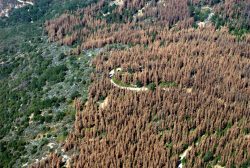
A UW-led study in May showed that forest die-offs in specific regions of the U.S. can influence plant growth in other parts of the country. The largest impacts seen were from losing forest cover in California, a region currently experiencing dramatic tree mortality. First author Abigail Swann, an assistant professor of atmospheric sciences and biology, said, “These smaller areas of forest can have continental-scale impacts, and we really need to be considering this when we’re thinking about ecological changes.”
June 2018
Warmer climate will dramatically increase the volatility of global corn crops
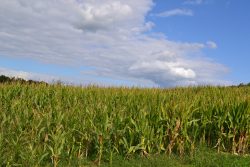
In June, new research looked at what climate change will mean for global yields of corn — the most widely grown crop in the world. The results showed that warmer temperatures by the end of this century will reduce yields throughout the world. It also showed dramatic increases in the variability of corn yields from one year to the next and a likelihood of simultaneous low yields across multiple high-producing regions, which could lead to price hikes and global shortages. “We find that as the planet warms, it becomes more likely for different countries to simultaneously experience major crop losses, which has implications for food prices and food security,” said UW Atmospheric Sciences‘ Michelle Tigchelaar.
July 2018
Sea-level rise report contains best projections yet for Washington’s coasts
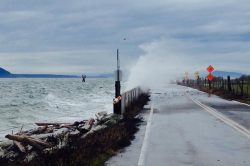
In July, a report led by Washington Sea Grant and the Climate Impacts Group provided the clearest picture yet of what we can expect to see in Washington state in terms of sea-level rise on our coasts. The report included projections for more than 150 sites in Washington, incorporating the geology-driven land motion. “One of the things we’ve heard from the planners we have shown it to so far is, ‘Hey, for the first time we have something that we feel is actionable,” said Washington Sea Grant’s Ian Miller.
August 2018
Policy pivot: A new emphasis on restoration to protect Puget Sound
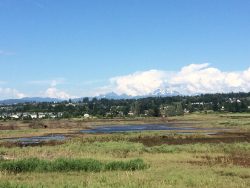
Through surveys and interviews with residents, tribal members, boaters, and state and federal agency contacts, a team of UW researchers and their collaborators found that policies are shifting toward restoration projects that include input from more groups and offer a range of benefits to Puget Sound, including flood control, salmon recovery, recreation, and habitat protection. “Understanding how to manage resources in Puget Sound is going to require understanding how different social groups use and interact with these resources going back many thousands of years,” said UW School of Marine and Environmental Affairs and International Studies‘ Patrick Christie.
September 2018
Combining science and art to shift our thinking and spur action in a changing world

In September, we highlighted the work of Program on the Environment alumni Tyler Ung. Although most Americans say climate change is an important topic, research shows fewer than half see it talked about in the media and just one in five discuss it with their peers. Science communication, or moving science outside of the walls of academia, isn’t easy — but it’s imperative. “In science, we’re taught to act inhuman to remain objective. On the other hand, art has been a method of communication since our ancestors could draw on rocks, but a common response to art is, ‘I don’t get it,'” Ung said. “If we’ve got senators throwing snowballs, we know we have a gap in communicating science into public discourse.”
October 2018
Former Interior Secretary Sally Jewell brings leadership to UW community, new EarthLab initiative
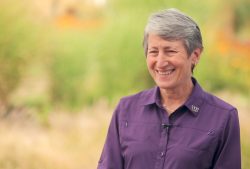
In October, it was announced that former Interior Secretary Sally Jewell would be the volunteer advisory council chair for UW’s EarthLab initiative. Jewell’s lifetime of experience in business, nonprofits, government and the outdoors helps EarthLab connect University of Washington scholars with community partners to solve the world’s urgent environmental problems. “By coming to the university, I’m trying to help students understand how you can create a future that’s both economically successful and environmentally sustainable — one that you are proud to leave to future generations,” said Jewell, who received her bachelor’s degree in mechanical engineering at the UW and served on the Board of Regents for 12 years.
November 2018
Racial, ethnic minorities face greater vulnerability to wildfires
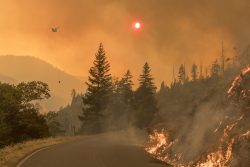
Researchers at UW’s School of Environmental and Forest Sciences and The Nature Conservancy used census data in November to develop a “vulnerability index” to assess wildfire risk in communities across the U.S. Their results showed that racial and ethnic minorities face greater vulnerability to wildfires compared with primarily white communities. Native Americans are six times more likely than other groups to live in areas most prone to wildfires. “A general perception is that communities most affected by wildfires are affluent people living in rural and suburban communities near forested areas,” said lead author Ian Davies, a graduate student in environmental and forest sciences. “But there are actually millions of people who live in areas that have a high wildfire potential and are very poor, or don’t have access to vehicles or other resources, which makes it difficult to adapt or recover from a wildfire disaster.”
December 2018
Biggest extinction in Earth’s history caused by global warming leaving ocean animals gasping for breath
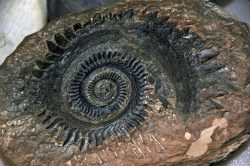
New research from the University of Washington and Stanford University combines models of ocean conditions and animal metabolism with published lab data and paleoceanographic records to show that the Permian mass extinction in the oceans, some 252 million years ago, was caused by global warming that left animals unable to breathe. As temperatures rose and the metabolism of marine animals sped up, the warmer waters could not hold enough oxygen for them to survive. UW Oceanography‘s Justin Penn said, “This is the first time that we have made a mechanistic prediction about what caused the extinction that can be directly tested with the fossil record, which then allows us to make predictions about the causes of extinction in the future.”
by Kelly Knickerbocker

